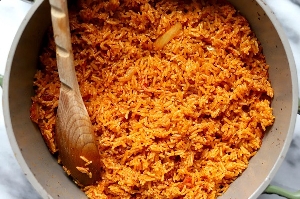 The cost of making Nigeria’s favorite jollof rice dish almost doubled in January 2024
The cost of making Nigeria’s favorite jollof rice dish almost doubled in January 2024
The cost of making Nigeria’s favorite jollof rice dish, a beloved delicacy in many homes, almost doubled in January from a year earlier in a reminder of the cost-of-living crisis facing Africa’s most populous nation.
The price of 1 kilogram (2.2 pounds) of rice, the main ingredient in making jollof, jumped 98.5% from a year earlier, data published Monday by the National Bureau Statistics showed.
Prices of other ingredients in the frequently consumed meal also jumped. A kilogram of tomatoes rose 81% while the same quantity of onions were up 97.4% within the same period.
Inflation accelerated to an almost three-decade high of 29.9% in January in the West African nation, where about 40% of the people live in extreme poverty. Food costs, which rose at an average rate of 35.4% in the same month, has been the main driver the rising cost of living that has triggered protests in several towns.
The Nigerian Labour Congress, the main union for workers in the country, is staging demonstrations against increasing hardship and insecurity in the country on Tuesday, while the central bank is expected to raise interest rates sharply to curb price pressures.
Governor Olayemi Cardoso will begin a press conference to discuss the decision of the monetary policy committee at around 2 p.m. in Abuja, the capital.
The inflation rate has exceeded the upper end of the central bank’s target range of 6% to 9% since 2015. The MPC raised rates by a combined 725 basis points to 18.75% between May 2022 and July 2023, when it last met.
The current gathering is the first meeting under Cardoso, who was appointed in September along with four new deputy governors. The other seven members of the committee are also new, with their appointments only confirmed by lawmakers this month.
Analysts expect the committee to hike rates significantly to curb rising inflation and stabilize the naira, which has lost about 70% of its value since June, when the central bank allowed it to trade more freely against the dollar. The sharp devaluation in the currency, as well as an end to subsidies on gasoline, have been a significant source of inflation.